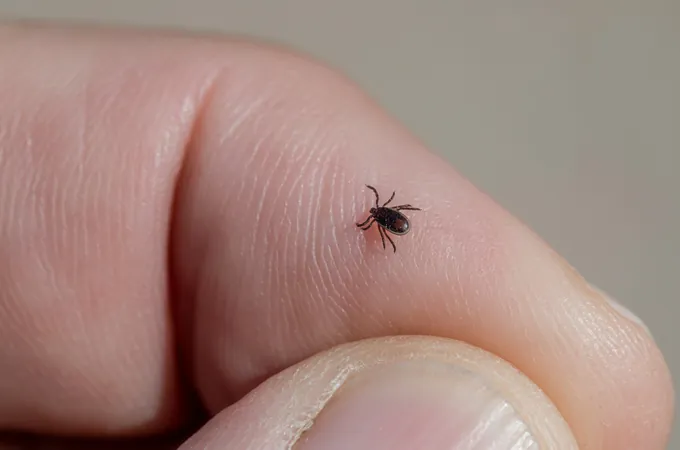
Breakthrough in Tick-Borne Disease Vaccines: New Library Unveils Key Targets!
2025-04-02
Author: Nur
Breakthrough in Tick-Borne Disease Vaccines
In a remarkable stride towards combating tick-borne diseases, a groundbreaking study from the Yale School of Medicine has revealed potential targets for vaccines and diagnostic tests. Published on March 26 in *Science Translational Medicine*, this research aims to address the rising threat these diseases pose to public health.
Understanding the Threat of Ticks
The deer tick, scientifically known as *Ixodes scapularis*, is notorious for transmitting several serious infections such as Lyme disease, babesiosis, anaplasmosis, and the Powassan virus. Alarmingly, Lyme disease affects around 500,000 Americans every year. The spread of tick-borne illnesses is compounded by climate change, which is enabling tick species to roam into new territories, potentially affecting more people at risk.
Research Focus and Goals
Erol Fikrig, MD, who leads the research and holds esteemed positions in medicine and epidemiology at Yale, highlighted the dual focus of the study: “We aimed to identify the targets recognized by the immune system post-tick bite, which could help improve diagnostic tests and pave the way for an anti-tick vaccine.”
The Challenge of Tick Immunity
Ticks are notorious for evading the human immune response by releasing proteins that numb the bite and suppress immunity. Interestingly, some animal species have developed a natural resistance to tick bites, which prevents ticks from feeding effectively. Anecdotal reports from hikers and gardeners suggested that humans might also be developing a similar form of resistance, adding weight to the argument for the feasibility of a vaccine.
Innovative Research Methodology
The challenge, however, lies in the fact that ticks secrete thousands of proteins, making it difficult to pinpoint those that the human immune system can recognize. To tackle this, the team created the I. scapularis rapid extracellular antigen monitoring library, known as the IscREAM library. This innovative technology employs engineered yeast cells to display each of the approximately 3,000 possible antigens from the deer tick, allowing comprehensive mapping of immune responses.
Significant Findings
By testing serum samples from 52 Lyme disease patients, the researchers found that 33 individuals recognized at least one antigen, with an impressive average of eight antigens picked up per patient, summing up to a total of 177 recognized antigens. This discovery broadens the horizon for potential vaccine targets.
Anecdotal Evidence of Human Resistance
Additionally, the study confirmed earlier anecdotal evidence of human tick resistance. Serum from a volunteer who reported experiencing resistance was successfully transferred to guinea pigs, which then displayed similar resistance traits.
Promising Vaccine Experiments
In an exciting experiment, guinea pigs were vaccinated with an mRNA vaccine targeting 25 antigens linked to the tick's cement—a substance that facilitates its attachment to hosts. The vaccinated guinea pigs demonstrated a marked resistance to tick bites.
Future Research and Optimism
While there is considerable variability in immune responses to Lyme disease among individuals, Fikrig acknowledges that more research is needed to identify which antigens could serve as reliable biomarkers for tick bites. However, the results of the mRNA vaccine experiments are promising.
Conclusion and Hope for the Future
Fikrig expresses optimism for the future, stating, “Based on the targets identified in our research pertaining to tick cement, an anti-tick vaccine appears feasible, and I am hopeful we will see advancements in this area within the next five to ten years.”
As the threat of tick-borne diseases continues to rise, this innovative research could be a critical turning point toward developing protective measures that could save countless lives. Stay tuned for further updates on this thrilling journey in medical science!


 Brasil (PT)
Brasil (PT)
 Canada (EN)
Canada (EN)
 Chile (ES)
Chile (ES)
 Česko (CS)
Česko (CS)
 대한민국 (KO)
대한민국 (KO)
 España (ES)
España (ES)
 France (FR)
France (FR)
 Hong Kong (EN)
Hong Kong (EN)
 Italia (IT)
Italia (IT)
 日本 (JA)
日本 (JA)
 Magyarország (HU)
Magyarország (HU)
 Norge (NO)
Norge (NO)
 Polska (PL)
Polska (PL)
 Schweiz (DE)
Schweiz (DE)
 Singapore (EN)
Singapore (EN)
 Sverige (SV)
Sverige (SV)
 Suomi (FI)
Suomi (FI)
 Türkiye (TR)
Türkiye (TR)
 الإمارات العربية المتحدة (AR)
الإمارات العربية المتحدة (AR)